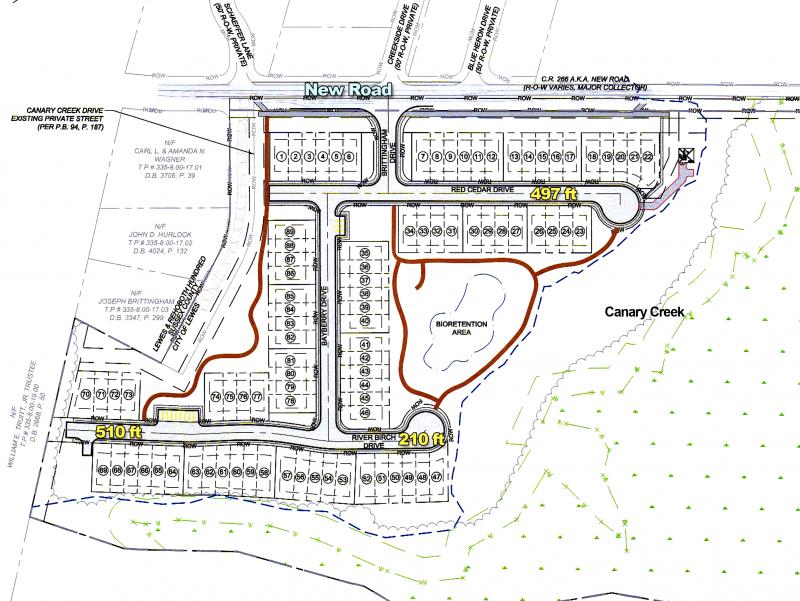Going against a recommendation from the planning commission, Lewes Mayor and City Council granted waivers for dead-end streets in the proposed Lewes Waterfront Preserve major subdivision.
Setting Properties Inc., developer of the property, had sought relief from the city’s 200-foot maximum length for permanent dead-end streets. The final plan for the 89-unit townhouse community along New Road features four dead-end streets, including three that exceed the city’s limit at 210 feet, 497 feet and 510 feet.
Jim Fuqua, the developer’s attorney, argued the city should grant the waivers because designing the subdivision without the dead-end streets would result in an extraordinary hardship for his client and would be counter to the purposes of the city’s annexation-residential zoning district.
Based on the final design, development is clustered on about one-third of the 34-acre parcel, with all homes and roads outside the flood plain, Fuqua said. In addition to reducing disturbance to natural resources and environmentally sensitive areas, he said, the annexation-residential zoning district seeks to reduce the lengths of roads and utilities, and reduce the amount of paving and impervious surfaces. Those purposes, he said, call for more flexibility and efficiency in design.
Speaking for the planning commission, Commissioner Tom Panetta said the group’s main concern with the plan was the 510-foot road that ended in a Y turnaround. The commission was generally OK with the other streets that ended with a cul-de-sac, he said.
The developer said a Y-turnaround was chosen because it is not intended to be a permanent dead-end street. It will be a future connector to the neighboring parcel, if it is developed.
As a compromise, the developer has agreed to build a temporary cul-de-sac instead of the Y-turnaround. If the neighboring property is developed, the cul-de-sac can be removed and the road restored to a normal street.
Councilman Rob Morgan was the lone vote against.
“I don’t think an extraordinary hardship is shown by having to redesign this,” he said.
As the project relates to inhibiting the purpose of the annexation-residential zoning district, Morgan said it seems possible for the developer to redesign the subdivision and still adhere to the stated purposes.
“To grant waivers seems to be a departure from good practice,” he said.
Deputy Mayor Fred Beaufait said the state fire marshal signed off on the developer’s plan, and the city has approved other plans with dead-end streets longer than 200 feet in recent years, specifically Mariner’s Retreat, currently under construction off West Fourth Street.
“I think it’s important to note the developer has worked to adhere to the [zoning],” Beaufait said. “The plan has 50 percent open space and … all construction is outside the flood plain.”
Council appeared unsure when and why a 200-foot maximum was set when other municipalities and jurisdictions allow longer dead-end streets.
Tom West, Lewes’ planning consultant, said the Delaware Department of Transportation’s manual for road design says an appropriate length for dead-end streets is 500 to 1,000 feet, depending on the density of the proposed development. A general rule of thumb for maximum length is that no more than 20 single-family homes should be served by a dead-end street, West said.
In Lewes Waterfront Preserve, about 23 of the 89 units will be located on the 510-foot dead-end street.
In Rehoboth Beach, the standard is no longer than 250 feet or no more than 10 lots abutting the dead-end street. In Milton, the standard is a maximum length of 400 feet. In Sussex County, code states maximum length of dead-end streets shall not exceed 300 feet without an additional alternative turnaround and not serve more than four dwellings.
Mayor Ted Becker voted in favor of the waivers. He said he understands the limitations in designing the project while attempting to preserve wetlands and open space.
Nick Roth is the news editor. He has been with the Cape Gazette since 2012, previously covering town beats in Milton and Lewes. In addition to serving on the editorial board and handling page layout, Nick is responsible for the weekly Delaware History in Photographs feature and enjoys writing stories about the Cape Region’s history. Prior to the Cape Gazette, Nick worked for the Delmarva Media Group, including the Delaware Wave, Delaware Coast Press and Salisbury Daily Times. He also contributed to The News Journal. Originally from Boyertown, Pa., Nick attended Shippensburg University in central Pennsylvania, graduating in 2007 with a bachelor’s degree in journalism. He’s won several MDDC awards during his career for both writing and photography. In his free time, he enjoys golfing, going to the beach with his family and cheering for Philadelphia sports teams.





















































